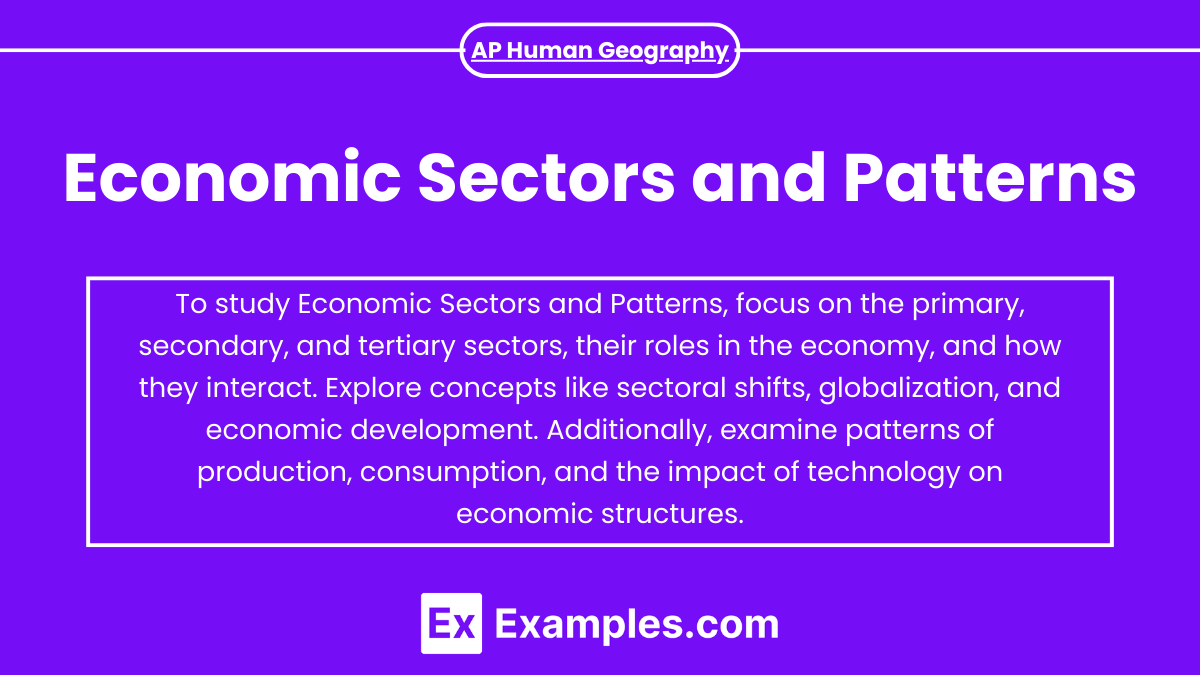In AP Human Geography, the topic of Economic Sectors and Patterns explores how economic activities are categorized into primary, secondary, tertiary, quaternary, and quinary sectors. Each sector represents a different stage in the production process, from raw material extraction to high-level decision-making. These sectors are distributed globally, shaping regional economies and driving globalization. Understanding economic sectors and their spatial patterns provides insight into how economies develop, shift, and interact on both local and global scales, influencing economic growth and geographic organization.
Learning Objectives
In studying “Economic Sectors and Patterns” for AP Human Geography, you should focus on understanding the classification of economic activities into primary, secondary, tertiary, quaternary, and quinary sectors. You will learn how these sectors relate to economic development and industrialization, recognizing spatial distribution and economic patterns globally. You should also be able to analyze how core, semi-periphery, and periphery regions differ in their economic structures and development. Finally, you will explore indicators of economic development and their relevance to different sectors.
Economic Sectors and Patterns: AP Human Geography
Understanding economic sectors and their patterns is crucial for success in the AP Human Geography exam. Economic activities can be categorized into distinct sectors that reflect different stages of the production process. Each sector is interrelated and plays a vital role in the organization of a region’s economy. Here’s an in-depth look at the topic:
1. Primary Sector
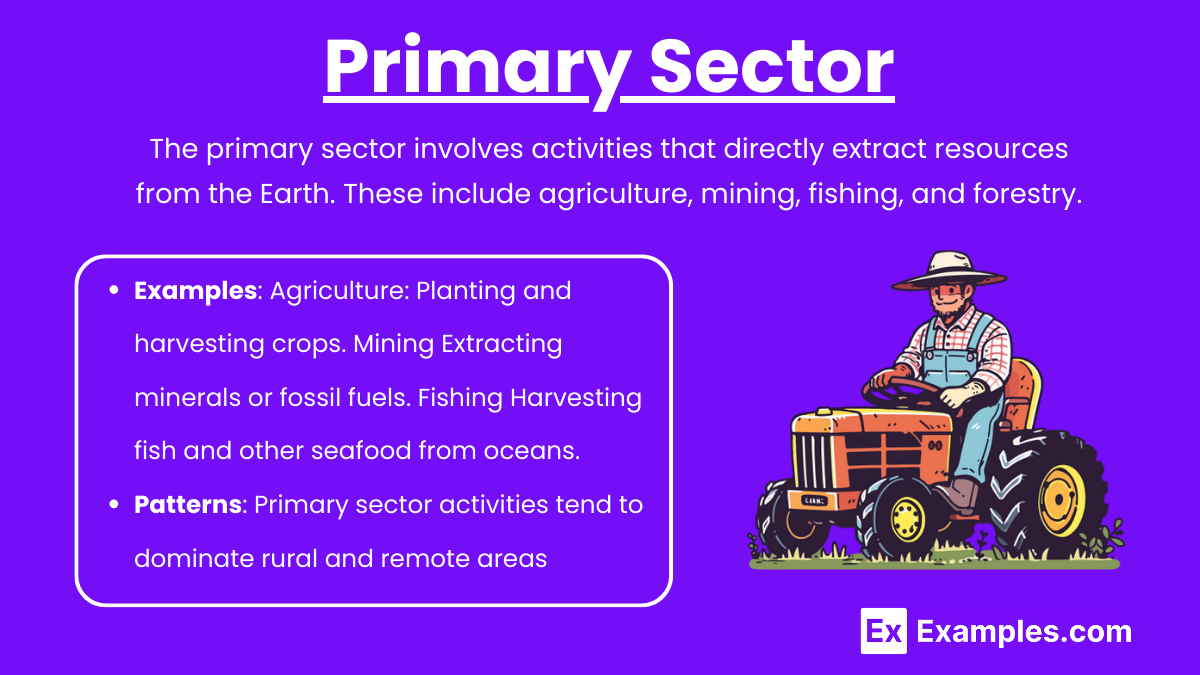
The primary sector involves activities that directly extract resources from the Earth. These include agriculture, mining, fishing, and forestry. This sector is most common in less developed countries (LDCs), where many people rely on subsistence farming.
- Examples:
- Agriculture: Planting and harvesting crops.
- Mining: Extracting minerals or fossil fuels.
- Fishing: Harvesting fish and other seafood from oceans and rivers.
- Patterns: Primary sector activities tend to dominate rural and remote areas, particularly in countries with abundant natural resources. These activities are labor-intensive and are often situated near the resource being harvested.
2. Secondary Sector
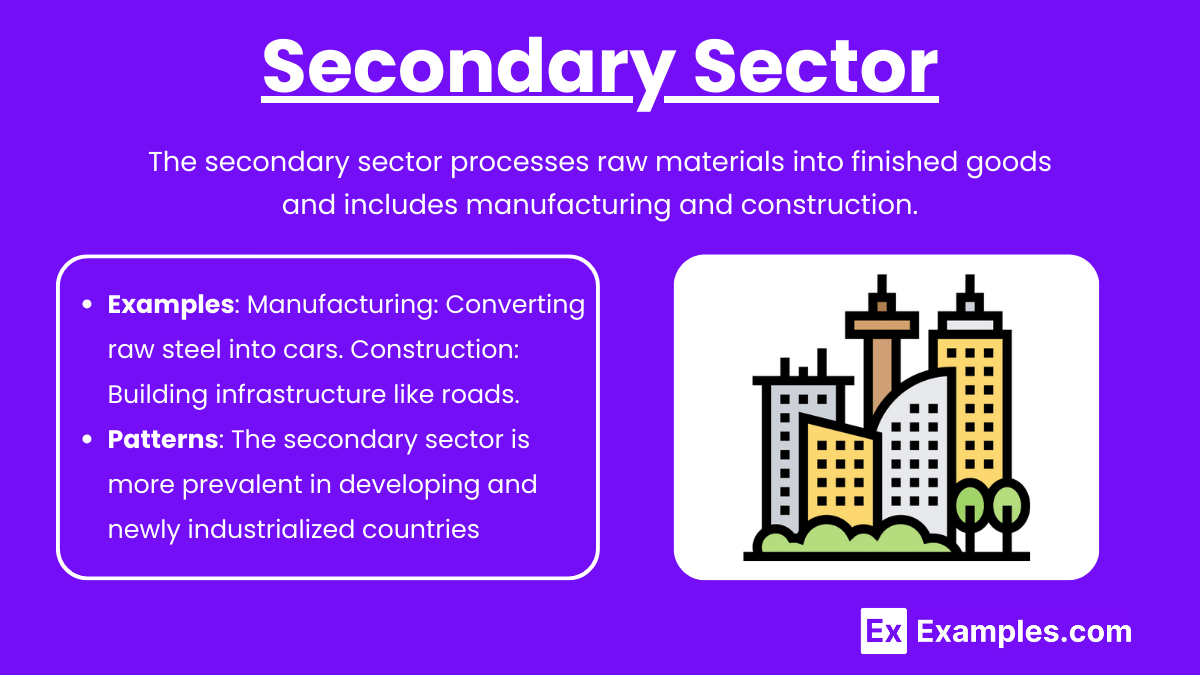
The secondary sector takes the raw materials from the primary sector and manufactures goods. This sector involves industrial processes and includes construction, factory work, and production of consumer goods.
- Examples:
- Manufacturing: Converting raw steel into cars.
- Construction: Building infrastructure like roads, bridges, or homes.
- Patterns: The secondary sector is more prevalent in developing and newly industrialized countries, where manufacturing contributes significantly to economic growth. Factories are often located near cities to take advantage of transportation networks, labor availability, and market proximity.
3. Tertiary Sector
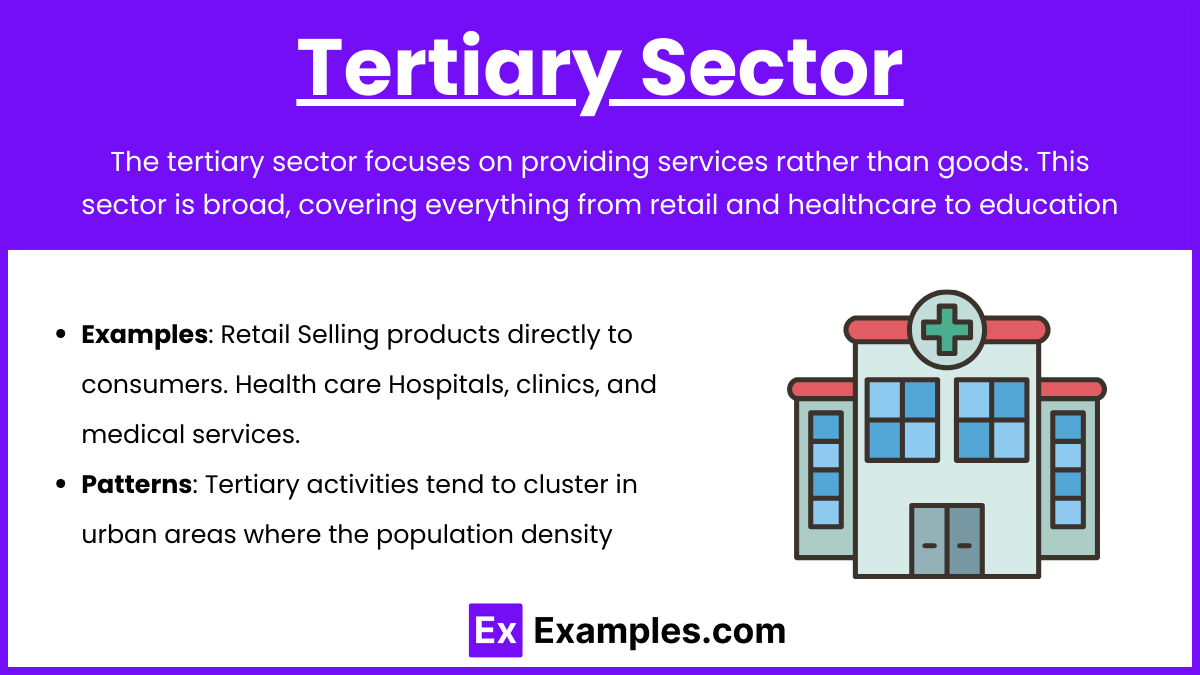
The tertiary sector focuses on providing services rather than goods. This sector is broad, covering everything from retail and healthcare to education and tourism.
- Examples:
- Retail: Selling products directly to consumers.
- Health care: Hospitals, clinics, and medical services.
- Tourism: Services provided to tourists, including hotels and travel agencies.
- Patterns: Tertiary activities tend to cluster in urban areas where the population density supports a broad range of services. Advanced economies have a large tertiary sector because of the shift towards service-based economies.
4. Quaternary Sector

This sector is concerned with intellectual services and the handling of information, knowledge, and research. It includes education, technology, data processing, and government roles.
- Examples:
- Research and Development: Innovation in technology and medicine.
- Education: Universities and training centers.
- Information Technology: Software development, data analysis.
- Patterns: Quaternary activities are most prominent in highly developed countries where the emphasis is on innovation and knowledge-driven industries. High-tech clusters like Silicon Valley are examples of quaternary sector hubs.
5. Quinary Sector

The quinary sector involves high-level decision-making and includes top executives, government officials, and leaders in research and science. These are the individuals who make critical economic, political, and social decisions.
- Examples:
- CEOs: Top-level executives of major companies.
- Government leaders: Politicians, diplomats.
- Academic researchers: Leading scholars in their fields.
- Patterns: Quinary sector activities are concentrated in global cities and capitals where major corporations and government institutions are headquartered. These cities, such as New York, London, and Tokyo, are decision-making centers of the global economy.
Economic Patterns and Geographic Theories
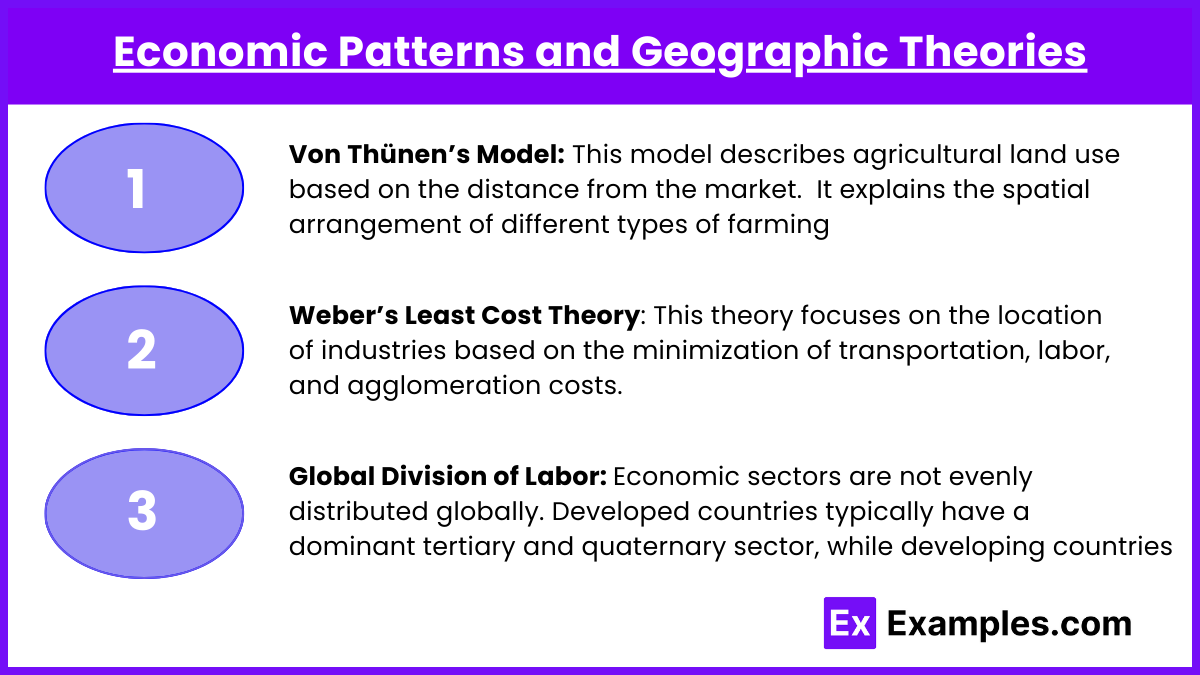
Different geographic theories explain how these sectors are spatially distributed across the globe:
- Von Thünen’s Model: This model describes agricultural land use based on the distance from the market. It explains the spatial arrangement of different types of farming, where perishable items like dairy are produced close to cities, and less perishable items, like grain, are farther away.
- Weber’s Least Cost Theory: This theory focuses on the location of industries based on the minimization of transportation, labor, and agglomeration costs. Factories are located to reduce the costs of transporting raw materials and finished goods.
- Global Division of Labor: Economic sectors are not evenly distributed globally. Developed countries typically have a dominant tertiary and quaternary sector, while developing countries are more reliant on the primary and secondary sectors. Globalization has led to a global division of labor, where different regions specialize in different types of economic activity.
Examples
Example 1: Agricultural Activities in Sub-Saharan Africa (Primary Sector)
In Sub-Saharan Africa, many countries still rely heavily on the primary sector, particularly subsistence agriculture. Most of the population engages in farming, growing crops such as maize, millet, and cassava primarily for local consumption. The region’s reliance on agriculture makes it vulnerable to environmental challenges like droughts and floods. This pattern of economic activity reflects a traditional economy, where limited technology and investment lead to low productivity and underdevelopment.
Example 2: Manufacturing in China (Secondary Sector)
China’s economy has experienced a significant transformation due to the rapid expansion of the secondary sector, especially in manufacturing. The country is a global hub for the production of goods like electronics, textiles, and automobiles. Factories are located in major urban centers such as Shanghai and Shenzhen, where access to ports and labor is abundant. This industrialization has led to China becoming one of the world’s largest economies, with a significant portion of its workforce engaged in factory work.
Example 3: Tourism in Spain (Tertiary Sector)
Spain’s economy heavily relies on the tertiary sector, with tourism being a leading industry. Popular destinations like Barcelona, Madrid, and the Canary Islands attract millions of tourists annually, contributing substantially to the country’s GDP. The presence of services such as hotels, restaurants, and transportation systems highlights the prominence of tertiary activities. This pattern is typical of developed economies, where services are a major economic driver, supporting urban areas and creating jobs.
Example 4: Technology and Innovation in Silicon Valley, USA (Quaternary Sector)
The quaternary sector in Silicon Valley represents a knowledge-based economy, with companies focusing on research, innovation, and technology. Firms like Apple, Google, and Facebook lead the global tech industry, providing intellectual services such as software development, data analysis, and research and development (R&D). This cluster of high-tech firms attracts skilled workers and capital investment, making it a key player in the global information economy and a model for modern economic development.
Example 5: Government and Decision-Making in Washington, D.C. (Quinary Sector)
Washington, D.C., represents the quinary sector through its role as a center for high-level decision-making. As the capital of the United States, it is home to top government officials, politicians, and international organizations such as the World Bank and the International Monetary Fund (IMF). These institutions influence global economic policies and decisions, showcasing how the quinary sector involves leadership and governance at the highest levels. This sector’s activities are concentrated in global cities with political and economic influence.
Multiple Choice Questions
Question 1
Which of the following activities is an example of a tertiary sector activity?
A) Fishing in the coastal areas of Alaska
B) Assembling cars in a factory in Detroit
C) Providing legal services in a law firm in New York City
D) Extracting coal from mines in West Virginia
Answer: C) Providing legal services in a law firm in New York City
Explanation:
- Tertiary Sector refers to services rather than goods production. Legal services fall under this category as they involve the provision of knowledge and expertise rather than the production of physical goods.
- A) Fishing is a primary sector activity because it involves the extraction of natural resources.
- B) Assembling cars is part of the secondary sector, which deals with manufacturing and industry.
- D) Extracting coal is a primary sector activity, as it involves mining, a resource-extraction process.
Question 2
In which economic sector would you classify software development, and where is it most commonly found?
A) Primary sector, in rural areas
B) Secondary sector, in manufacturing hubs
C) Tertiary sector, in suburban regions
D) Quaternary sector, in urban high-tech clusters
Answer: D) Quaternary sector, in urban high-tech clusters
Explanation:
- Software development is an intellectual activity associated with the quaternary sector, which includes knowledge-based industries like information technology, research, and development.
- A) Primary sector involves resource extraction and is usually found in rural areas (e.g., farming, mining).
- B) Secondary sector refers to manufacturing, such as producing cars or textiles, typically located in industrial regions.
- C) Tertiary sector refers to services like retail, healthcare, or tourism but does not specifically involve knowledge-intensive activities like software development.
- D) Quaternary activities are often concentrated in urban areas, particularly in high-tech clusters like Silicon Valley, where innovation and research are prominent.
Question 3
Which of the following trends is associated with deindustrialization in developed countries?
A) Increasing dominance of the primary sector
B) A shift from secondary sector jobs to tertiary and quaternary jobs
C) A rise in agricultural employment
D) The relocation of service jobs to rural areas
Answer: B) A shift from secondary sector jobs to tertiary and quaternary jobs
Explanation:
- Deindustrialization refers to the decline of industrial (secondary sector) activity in developed countries, leading to a rise in service (tertiary sector) and information-based (quaternary sector) employment.
- A) Increasing dominance of the primary sector is incorrect as developed countries tend to reduce dependence on the primary sector over time, focusing more on services and technology.
- C) A rise in agricultural employment is not a trend in deindustrialized economies, as they typically shift away from agriculture and resource extraction.
- D) The relocation of service jobs to rural areas is incorrect because most tertiary and quaternary jobs are concentrated in urban and suburban areas due to access to markets, infrastructure, and skilled labor.

